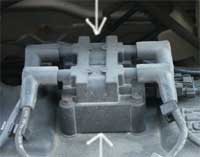Automotive Terms Dictionary
A B C D E F G H I J K L M N O P Q R S T U V W X Y Z
D-Pillar or D-Post
The vertical or sometimes diagonal roof supporting member located at the
extreme rear of the roof or greenhouse structure on station wagons and some
sedan models.
Die
solid or hollow form used for shaping materials by stamping, pressing, extruding,
drawing or threading.
Diesel Engine
A diesel engine uses heavier weight components than gas engines to handle
higher compression ratios. Typically, diesel engines run with greater efficiency
and higher torque than similar size gas engines. These attributes lead to
better fuel economy and towing performance. Diesel engines do not have spark
plugs or carburetors. Instead glow plugs are used to preheat air in the
cylinders to ensure easy starts. Once the engine is started, compression
heats the fuel in the cylinders for combustion.
Dieseling
A condition in which gasoline continues to fire after the ignition has been
shut off. In late-model engines, dieseling , or run-on, is caused by heat
and the unusually high manifold pressure that result from retarding the
spark at idle. In fuel-injected cars when the engine is turned off, fuel
is automatically shut off, eliminating dieseling.
Differential
The gear assembly connected to the drive shaft that permits the wheels to
turn at different speeds when going around a corner, while transmitting
power from the drive shaft to the wheel axles.
Differential, Locking
The same attributes of a standard differential, except that when one wheel
is slipping, the most torque is supplied to the wheel with best traction.
A locking differential reduces the possibility of a vehicle becoming immobile
when one driving wheel loses traction.
Directional Stability
A vehicle's ability to maintain a true course of travel despite bumps, crosswinds,
uneven road surfaces.
Disc Brakes
Properly called caliper disc brakes, a type of brake that consists of a
rotor that rotates at wheel speed, straddled by a caliper that can squeeze
the surfaces of the rotor with brake pads near its edge. Disc brakes provide
a more linear response and operate more efficiently at high temperatures
and during wet weather than drum brakes.
Displacement
In an engine, the total volume of air or air-fuel mixture an engine is theoretically
capable of drawing into all cylinders during one operating cycle. Generally
expressed in liters or cubic inches. Engine displacement is equal to (bore)
x (bore) x (stroke) x (number of pistons) x (.785).
| Distributor
A component of the ignition system, usually driven by the camshaft that directs high-voltage surges to the spark plugs in the proper sequence. |
 |
Double Wishbone Suspension ("A" Arm Suspension)
A system of independent suspension in which each wheel is located on a "knuckle"
that is connected by ball joints to an upper A arm and a lower A arm. Usually,
the lower A arms are longer. This system provides minimal changes in track
and camber when the suspension is under load, as when going over bumps or
in hard cornering.
Drag Coefficient
A measure of the aerodynamic sleekness of an object. Drag coefficient is
signified by "dc.: The lower the number, the greater the aerodynamic
efficiency. The higher the drag coefficient, the more a car's engine must
work to keep a given road speed. Also known as "CD" for coefficient
of drag."
Drive Shaft
The shaft that transmits power from the transmission to the differential
in a rear-drive power train.
Drivetrain
The power-transmitting components in a car, including clutch, gearbox (or
automatic transmission), driveshaft, universal joints, differential and
axle shafts.
Dual Overhead Camshafts (DOHC)
A DOHC engine has two camshafts in each cylinder head; one camshaft actuates
intake valves and the other actuates exhaust valves. The camshafts act directly
on the valves, eliminating pushrods and rocker arms. This reduced reciprocating
mass of the valve train enables the engine to build RPM more quickly. DOHC
designs are typically high-performance, four valve per cylinder engines.
(A four valve per cylinder two intake and two exhaust design helps the engine
"breathe" more freely for increased performance.)
Dynamometer
A device which absorbs and measures the power derived by an internal combustion
engine.
MORE FROM CDNAUTO

Canada gas tax breakdown per province - Each litre of gas you're buying, how much of that amount is going to your government? View breakdown across all provinces.

High gas prices? Think again. - So you think you're paying too much for gas?. Take a look at pricing of gas around the world and see how Canada stacks up against other countries.

With gas prices surpassing $1 dollar mark we take a look at other fuel
alternatives. Hybrid vehicles, CNG, Propane and other alternatives.
Read our article on propane
and natural gas

Diesel engine technology has been around for quite some time now. See list of Diesel vehicles that are currently available to you.